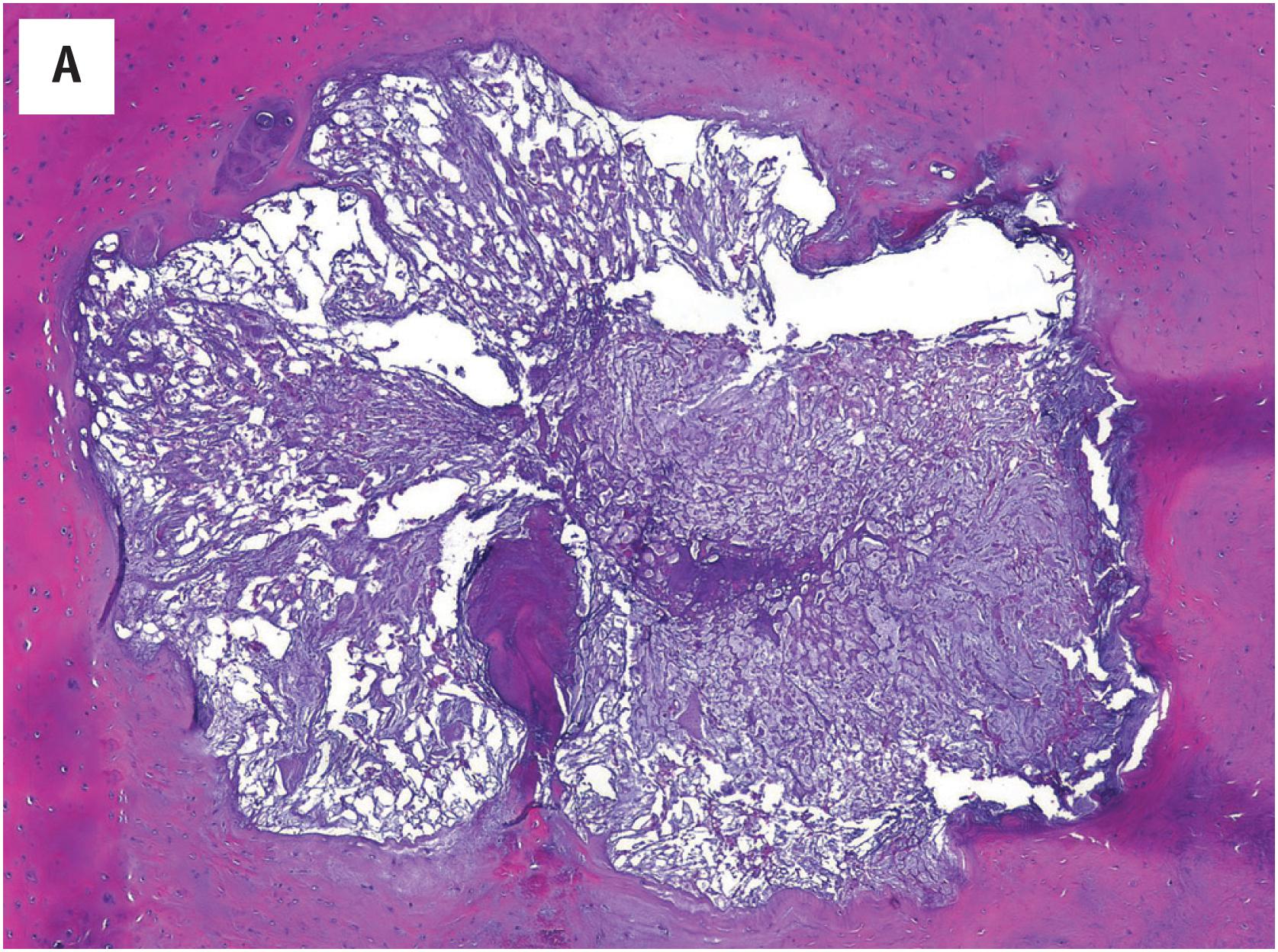Physical Address
304 North Cardinal St.
Dorchester Center, MA 02124
Notochordal remnants are small deposits of notochordal tissue that fail to regress after embryogenesis.
The notochord is an ectodermal-derived structure present in all organisms in the phylum Chordata and, as a major regulator of developmental signals in embryogenesis, plays a critical role in defining the primitive axial skeleton. Although it typically regresses by gestational week 10, it may be aberrantly arrested at any point in the process, leaving persistent notochordal remnants along its embryonic path. In adults, notochordal remnants can be found either at the base of the brain (ecchordosis physaliphora) or in the nucleus pulposus of the intervertebral disc. As the remnants within the nucleus pulposus are incidental findings and of no clinical significance, they will not be discussed further ( Fig. 21.1 ).

Ecchordosis physaliphora is typically an asymptomatic lesion that is incidentally identified on imaging. It is estimated to be present as an incidental finding in 0.4%–2% of autopsies. These lesions can very rarely be clinically symptomatic, most commonly with headache and diplopia.
Extraosseous, retroclival, at the base of the brain.
Characteristic MRI findings of ecchordosis physaliphora include a well-demarcated, homogeneous, and eccentric mass with attachment to the clivus by a bony stalk or pedicle. The lesions are typically hypointense on T1-weighted images and hyperintense on T2-weighted images, with lack of enhancement with gadolinium contrast, although atypical radiographic features can occasionally be seen.
Well-defined, round to oval, gelatinous nodules ranging in size from <2 mm to 2 cm ( Fig. 21.1A ).
Ecchordosis physaliphora consists of large cells with round to oval nuclei and abundant clear cytoplasm, arranged in cords and clusters with a variable amount of extracellular myxoid matrix ( Fig. 21.1B ). The overall histology is similar to that of conventional chordoma.
The cells of ecchordosis physaliphora and other notochordal remnants express keratins, S100 protein, and T-brachyury. As this is the same immunohistochemical profile as other notochordal tumors, immunohistochemical stains are not helpful in categorizing notochordal cell tumors.
No specific genetic abnormalities have been identified.
The differential diagnosis includes benign notochordal cell tumor and chordoma. Benign notochordal cell tumor is a sclerotic intraosseous lesion that almost never extends outside the bone; histologically, it has little or no extracellular myxoid stroma.
Chordoma arises within the bone of the vertebra and invariably extends into the soft tissues and is critical to exclude prior to making a diagnosis of ecchordosis physaliphora. As there is extensive histologic overlap between the two entities, correlation with radiographic findings is essential. Special care should be taken in symptomatic patients, as a symptomatic tumor is more likely to represent a chordoma.
No treatment is typically necessary, as these lesions are commonly incidental findings and asymptomatic. However, in exceptional cases of symptomatic lesions, surgery may be necessary to provide symptomatic relief.
As these lesions are usually incidental findings, they are typically of no clinical significance and have an excellent prognosis.
Benign notochordal cell tumor (BNCT) is an indolent intraosseous proliferation of notochordal cells. Although the nature of the relationship between BNCT and chordoma remains unclear, reported cases with juxtaposition of the two suggest that, very rarely, BNCT may undergo malignant transformation.
BNCT is a benign intraosseous lesion that is not uncommonly identified adjacent to chordoma either histologically or radiographically, raising the possibility that it might be a precursor lesion. That the distribution of BNCT within the axial skeleton is similar to that of chordoma as well as the presence of chromosomal imbalances lend some support to that hypothesis. Rarely, lesions that defy classification as BNCT or chordoma have been described with histology similar to that of BNCT but with evidence of cortical permeation or focal soft tissue extension. These unusual lesions have been provisionally designated “atypical notochordal cell tumors” (ACNT).
BNCTs are typically occult lesions and are incidentally identified on imaging. They have been reported to be present in up to 20% of individuals. Although typically asymptomatic, BNCTs may occasionally be mildly painful, and have rarely been described to cause incapacitating pain. The few cases of ACNT that have been reported are more commonly described as symptomatic lesions.
The most common locations are the clivus and sacrococcygeal vertebrae, followed by the cervical and lumbar vertebrae. Although they are typically solitary lesions, multifocal tumors have rarely been reported. Rare extraosseous cases have been described.
Become a Clinical Tree membership for Full access and enjoy Unlimited articles
If you are a member. Log in here